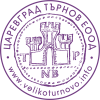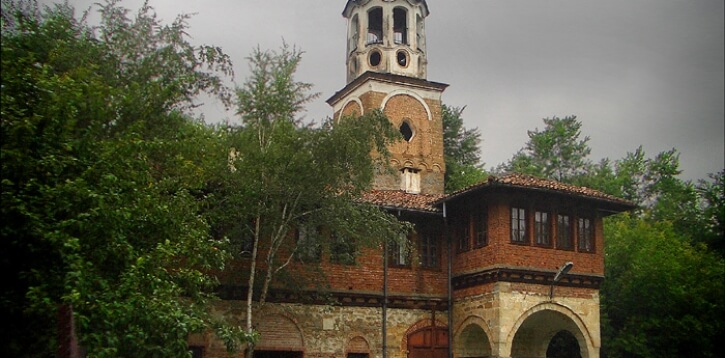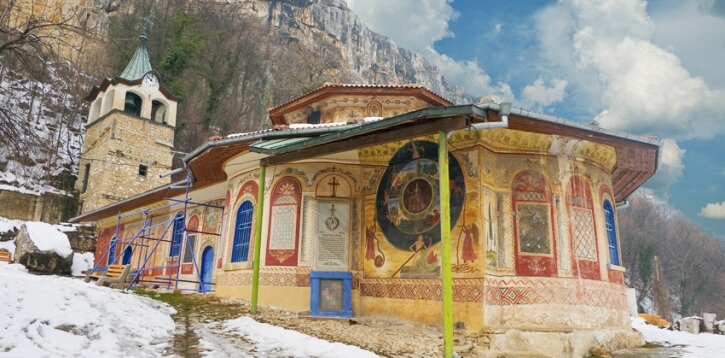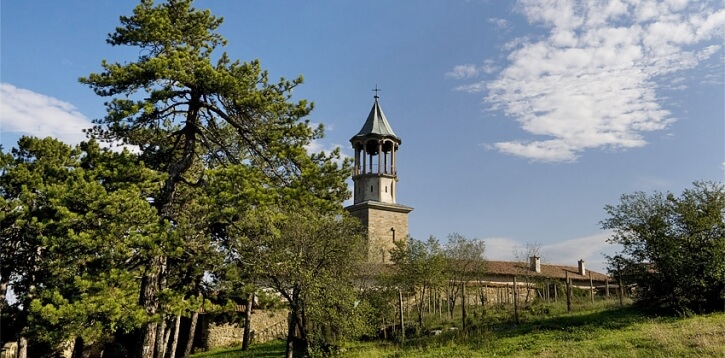An inscription on the eastern facade, above the apse of the Kapinovo Monastery’s cathedral church reads thus: “And first was there raised in the year 1272 a temple named the Holy Trinity, renovated in 1835.” This text clearly and definitely states that until 1835, on the site of the present-day cathedral church, there stood an older temple dated, according to an inscription non-existing today, to 1272 when Tsar Constantine Assen-Tikh (1257-1277) ruled.
According to some other obscure legends, the monastery’s foundation is ascribed to 1228 and Tsar Ivan II Assen is considered its originator. It is believed that during the Second Bulgarian Kingdom this place rose to the status of an important religious center in Northern Bulgaria. When the Turnovo Kingdom was overrun by the Turks, the Kapinovo Monastery was set on fire and abandoned. It was not until the close of the 17th century that countrymen from the nearby villages succeeded, through exhortation and bribe, in getting a permit from the Turnovo vali for the reconstruction of the old cloister. But for lack of a Sultan’s Firman, the. renovation of the dilapidated medieval church was carried out at night, and the new masonry and stucco were fire-blackened to assume old-time looks. A beadroll, containing interesting data about the monastery’s local history, is ascribed to 1700 but” during the following centuries no regular entries were made in it. Surviving from that time are altar gates and a woodcarved frieze while the bishop’s throne with fretwork is dating from the 18th century.
These were the scanty remains of the monastery after the conflagration of 1630, and its burning down to ashes in 1799 by a Kurdjalii’s gang. However, after these unfortunate events, life in it has never ceased. In 1794 appointed as its abbot for about two months was the eminent man of letters from the early Revival Period and ecclesiastic Stoiko Vladislavov,. the future Bishop Sophronius of Vratsa. This was the same man who as early as 1768, during a visit to the monastery, brought to the monks the Slav-Bulgarian History of Paissi. It was copied by Abbot Elephter, and its spread throughout the Turnovo region began from here.
At the turn of the 19th century the monastery gained popularity and began to better its position. However, the worn-out buildings which had many a time undergone repair, could no longer meet the demands of the clergy and the ever increasing number of visitors. For that reason its large-scale renovation began soon. Firstly, in 1835, when Nephtalim was abbot, the master-builders Pencho and Racho from Dryanovo raised a new cathedral church on the site of the medieval temple. It was a one-nave solid building with a comparatively wide parvis. In about 1845 a frame-built open narthex was added in front, which had small woodcut columns and a plastered concaved cornice. The man body of the church was built of crumbled stone. Bricks were used but only for the cornices. The interiors, scantily as they are lit only through a few small narrow windows, are sunk in semi-darkness.
It was in 1856 that the largest scale construction works began at the monastery, when the patriotic residents of Elena, the brothers Horozovski, going by their monastic names of Hadji Theodosius and Hadji Kessarius, donated funds for the erection of a new residential structure.
The work continued for eight years, up to 1864. Its completion was registered in an inscription engraved at the Presentation of the Holy Virgin Chapel reading thus: “In the year 1864 abbots and donors, all from this cloister, and the brothers Horozovski from Elena – Archimandrite Hadji Theodosius and clergyman Hadji Kessarius, built and painted with their own money this Holy Temple for the redemption of their souls and for eternal blessing.”
This structure, raised by unknown builders, most probably from Dryanovo and Tryavna, is one of the most handsome buildings throughout the Bulgarian lands. It is a three-storied construction from the outside while from the direction of the courtyard it has two floors. The lower levels accommodate cellars, cattle-sheds, a catering block, cells and guest rooms while the top floor houses the abbot’s place, guest rooms, cells, and a winter church with a built-in ossuary underneath, on a level with the courtyard.
The configuration of the structure is broken up so that to enclose the courtyard area still better. A variety of oriels and projections, and the white cupola of the winter church all blend in a perfect harmony of materials, plastic facade forms and colours with addition of numerous original wood-carvings, stone plastic ornaments and paintings. A real spectacle of a splendid and picturesque architectural style, the sight of which is a great experience of life for the visitor.
The 19th century history of the Kapinovo Monastery should not be restricted to its architectural and artistic achievements alone. During the Revival Period its monastic community never ceased to share in the spiritual and revolutionary struggles of the Bulgarian people. As early as 1830 Abbot Nephtalim set up a school at the monastery which produced a galaxy of grammarians and ecclesiastics. Five years later, in 1835, the plotters against the Ottoman Empire found shelter at this sacred abode which also contributed to the organization of the Hadji Stavri’s Rebellion in 1860, and partook in the preparations for the April Uprising.
The triptych beadroll of 1700, mentioned above, which is now treasured at the Archaeological Museum in Sofia, testifies to the existence of vigorous cultural activities at the monastery. Its front side displays the image of the tutelary Saint Nicholas accompanied by the figure of a clergyman, in all likelihood the monastery abbot. Stylistically, the paintings bear a semblance to a sizable group of icons (St Nicholas, St Elijah) of 1735, derived from the Kapinovo Monastery and kept today at the Art Gallery in the town of Elena. An icon of the Archangels’ Council found at the nearby Monastery of Prissovo bears the same date and the names of the Tryavna painters Nedyu, Georgi and Dragan. These facts attest that during the first half of the 18th century artists from Tryavna worked actively at the Kapinovo Monastery leaving numerous masterpieces of iconography and the art of wall-painting in the vicinity of Veliko Turnovo.
There is a woodcut iconostasis in the monastery church incorporating 18th century details (an Apostles’frieze with carved arches resembling the Apostles’ friezes of the Arbashki chancel-screens). There are interesting icons arranged in and out of the iconostasis. St Elijahin a Chariot with twelve hagiographic scenes, the Presentation of the Virgin, the Holy Virgin with Prophets, Christ with the Apostles are all from the 18th century. They are very much alike in style, manner of execution and size, and most probably belong to one and the same sequence of paintings.
Arranged in the iconostasis of the church are the images of St John the Precursor, Christ the Almighty, St Nicholas with twelve hagiographic scenes, the Holy Virgin, Archangel Michael with eight hagiographic scenes. The icons of St Nicholas and Archangel Michael have an inscription containing the name of Papa Vitan from Tryavna and the year 1811. The painting of the image of St John the Precursor can be attributed to the same author while the icon of the Holy Virgin bears the year 1820 and the name of loan Popovich, an artist from Elena. A source of particular interest are the woodcarved altar gates and the bishop’s throne from the early 19th century.
The monastery treasures a rich collection of icons arranged around the iconostasis: the Holy Virgin, probably painted by the hand of Papa Vitan; the Presentation of the Virgin, St Menas, Archangel Michael (1838); St Elijah in a Chariot, John the Precursor (1862) executed by Simeon Simeonov from Tryavna. This collection also contains icono-graphic works brought from the nearby Plakovo Monastery and the church in the village of Yovkovtsi which was overflowed by the waters of the dam known by the same name. These included the icons of St Menas of 1879, Sts Peter and Paul and Baptism of 1862, a complete set of icons representing a festal cycle painted by Simeon Tsanyuv from Tryavna, the Holy Virgin Enthroned of 1868 executed by the hand of the same artist, Christ the Almighty of 1872, painted by Simeon Tsanyuv, St Nicholas by Tsanyu Simeonov and Simeon Tsanyuv, altar gates, four panels arranged under the iconostasis, a cross above the iconostasis, all painted in 1871 by Simeon Tsanyuv and many other artists. The survey thus made reveals that some of the most famous painters from the Tryavna artistic school worked at the Kapinovo Monastery in the 18th-19th centuries.
The only decoration at the St Nicholas’ Principal Church are the paintings on the eastern wall of the open narthex which was annexed later from the south. The scene of the Last Judgement runs along the entire wall. In colour, characters and certain details it differs from the familiar images used to represent the theme in this region. An inscription in the middle of the composition testifies to the donations made by Hadji Nikola from Elena in 1845.
The name of the painter Yonko Petkovich can also be discerned here.
After the construction of the chief monastery body by the brothers Horozovski in 1856, the facade around the main entrance was adorned with paintings. Prominent among these are the large-sized figures of the Slav preceptors Sts Cyril and Methodius.
The Chapel of the Presentation of the Holy Virgin on the second floor was decorated in 1864, again with funds of the Horozovski brothers from Elena who erected the principal structure. Their group portrait with a model of the monastery buildings was depicted above the door of the chapel. Its southern wall displays a gallery of Bulgarian saints: St John of Rila, Ilarion of Muglen, the Reverend Petka of Turnovo, St Theodosius of Turnovo and many more. Comparing the style, characters, colours and other elements of these wall-paintings, one is led to believe that though written evidence is lacking, they were executed by the hand of the painter Alexi Atanassov who at that time worked in the Plovdiv region. In such a way the Kapinovo Monastery, whose foundations were laid as early as the Middle Ages, succeeded in carrying on through the centuries the Bulgarian cultural tradition, and has remained even to this day a veritable treasure-house of inestimable historical and artistic values.
The monastery is open for visitors from 7am to 7pm and overnight accommodation is available.








